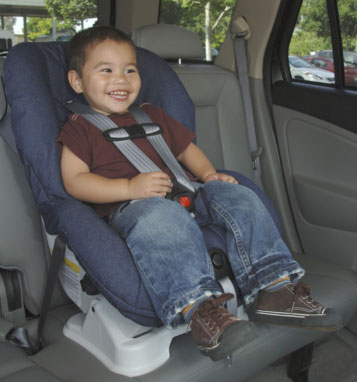Car Seat Safety
Fast Facts
- Legally, all children under age 6 and under 60 pounds must be restrained in a child safety seat that is appropriate for their age, weight, and height.
- Never place a rear-facing car seat in front of an active air bag.
- Car seats that have been in an accident should be replaced.
- Observe all warnings and expiration dates on car seats. Register your car seat for alerts.
- If the child is taller than the seat (their head comes above the top of the seat), it is time to upgrade.
- Look before you lock the car! Make sure you always check the car before locking and walking away. Keep your parked car locked to avoid entrapment if a child was to climb in.
Traveling with kids can be fun, stressful and, at times, very difficult. But, it is also necessary to get from point A to point B safely. Whether you’re taking children down the street or across the country, there are several things to remember to make traveling with children safer and easier.
What type of car seat is right for my child?
The CDC chart below provides basic guidelines for car seats based on your child's age and height.
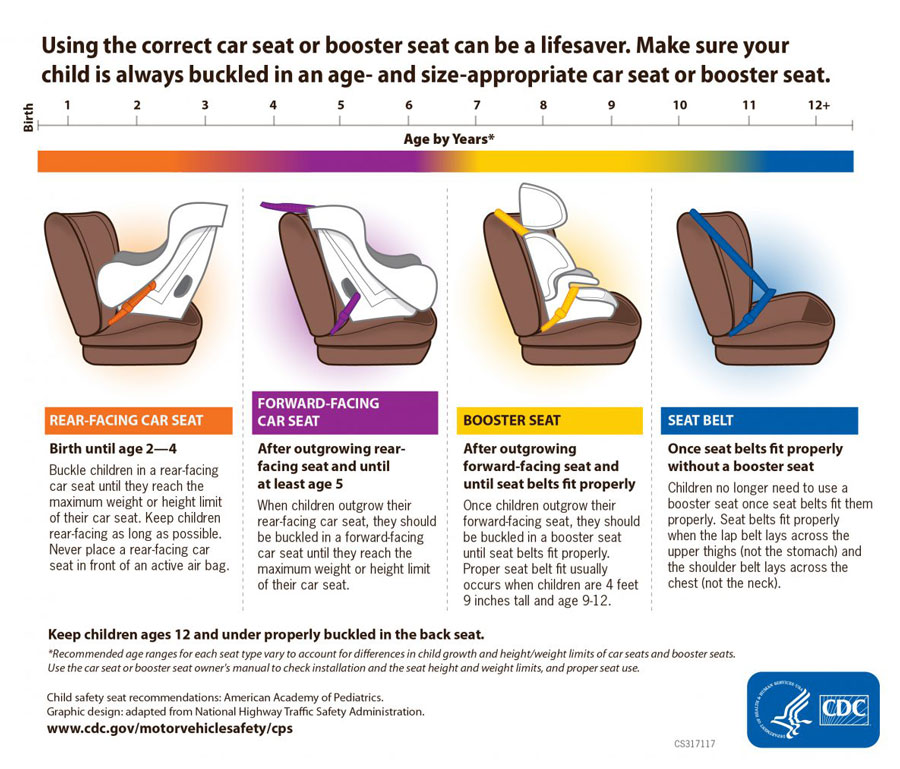 Click graphic to view larger size.
Click graphic to view larger size.
Older recommendations stated that a child could move from a rear-facing to a forward-facing car seat at age 1 and 20 pounds. Current recommendations say at least age 2, but children are safer rear-facing for as long as their seat is safe to do so (until the child reaches the upper weight and height limit for their seat). Many newer seats go up to 45 pounds while rear facing.
Unsure how to install a car seat properly? Contact a car seat technician.
If you would like someone to check your child’s car seat installation, car seat technicians are trained to check and install car seats. Visit http://cert.safekids.org/ for a searchable database. It will give you contact information for car seat technicians in your area.
Rear-Facing Car Seats
Infants under age 2 should be in a rear-facing seat. These seats may be carrier/bucket seats that have a base that stays installed in the car, or they may be convertible car seats that stay installed in the car and may be turned to face forward when the child meets age, height and weight requirements.
- When buckling a child into a rear-facing seat, check the tightness of the straps and
the position of the chest clip. If your child is in a carrier/bucket seat, lower the
handle behind the seat when clicking the seat into its already installed base.
- In the photo, the strap is tight. It will pass the “pinch test” (you cannot grab the
strap and pinch the slack).
- The chest clip is at armpit level. It should not be so high it hits the child in the neck, and it should not be at stomach or sternum. Armpit level is the safest to avoid internal injury. The bottom strap allows for tightening and release of the shoulder straps. Be sure to use this feature. All seats with a 5-point harness, like this one, will have a way to adjust the tightness of the straps.
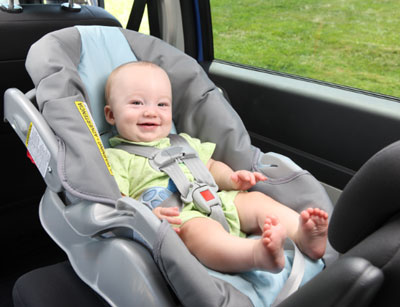
This is what the straps should look like: the strap is tight (passes “pinch test”) and the chest clip is at armpit level. (Photo Credit: NHTSA.gov)
- If you are using a bucket seat and you take the seat out in order to carry the child,
be sure you tighten the straps when you put the seat back in the car if you have loosened
them for the child’s comfort. Additionally, do NOT put a carrier seat on top of a shopping cart. This causes the shopping cart to be top-heavy and can cause severe injury if the
cart tips over.
- Familiarize yourself with the seat before you use it. If you are traveling with a
grandchild, niece or nephew, or other child using an unfamiliar seat, be sure to ask
questions to make sure you are comfortable enough to use the seat properly.
- Convertible infant seats are slightly different in installation, but the features described above are the same. With very small infants, you may have difficulty tightening the straps and keeping the chest clip at armpit level, but get as close as you can and as tight as you can. Many newer seats come with an insert that helps boost a newborn high enough to allow for proper belt position.
Forward-Facing Car Seats
Updated recommendations for forward-facing car seats say that children should stay rear-facing until at least age 2, but for as long as possible based on the weight and height limits of the seat being used. Following these recommendations with an appropriate seat increases the likelihood that a child will make it safely through most car accidents with only minor injuries.
Many parents worry about their older child rear-facing with their legs being uncomfortable. Most children will cross their legs or find a comfortable position while rear-facing. Staying rear-facing longer protects against spinal injuries.
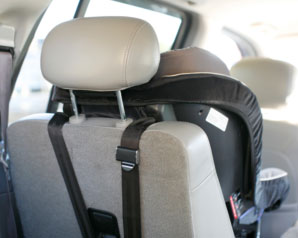
- Most convertible seats have a rear-facing limit of at least 45 pounds, and some go
as high as 65 pounds. If the child is taller than the seat (their head comes above
the top of the seat), it is time to upgrade to a different seat.
- When you decide to turn a child forward-facing, the pinch test and chest clip rules
still apply. The straps should be tight enough that the child cannot move around or
wiggle out of them, and the chest clip should be at armpit level.
- For children in rear- or forward-facing car seats, always remove a child’s winter coat before tightening straps. If it is cold in the car, remove the coat, tighten their straps, and put their coat on backward on TOP of the straps. This also allows the child to remove their coat without taking them out of their seat if they get hot.
Booster Seats
Moving to a booster seat is appropriate when a child is 5 or older and will sit properly in a seatbelt (i.e., they won’t put it behind their back or under their arms, and they will sit up in the car).
- Some booster seats have a belt positioner that keeps the seatbelt off of the child’s
neck. This will increase the likelihood that they will keep the belt in the correct
position.
- The booster raises the child to the correct height for the seatbelt to fit them by
lying flat across their chest and hips.
- Another option for this age group or as a transition between a forward facing and booster seat is a high-backed booster seat. They typically still have a 5-point harness, but they sit flatter and often have an adjustable head rest to fit the height of the child. This option is especially good for children who struggle to sit properly in their seatbelt.
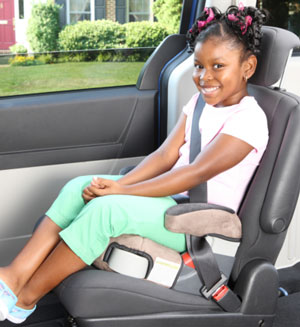
Option 1 - Regular Booster
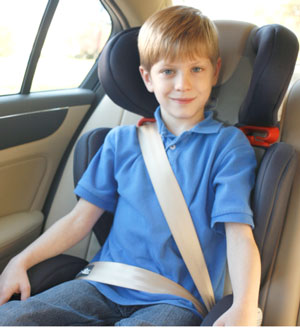
Option 2 - High-backed Booster
Seat Belt Only
When a child is 8 years or older (depending on height), they may be ready to sit in
the seat alone. Before setting out, be sure to check for seatbelt position: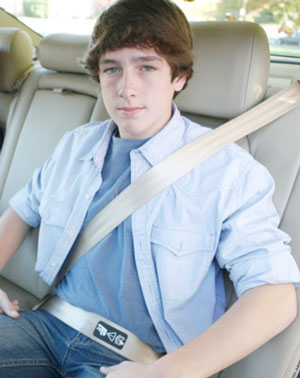
- The belt should lay flat across the child’s chest and not dig into their neck.
- It should lay across their hips or upper thighs NOT their stomach.
- They should be able to sit with their knees bent over the edge of the seat without
slouching down. If they are not yet able to do this, they should continue using a
booster seat until they are tall enough for the seatbelt to fit them properly.
- Children should still ride without putting the seatbelt behind them or under their arms.
Still need help finding the right car seat?
The National Highway and Traffic Safety Administration (NHTSA) has resources to help you find the right car seat that fits in your vehicle and keeps your child safe based on their height and weight.
Sun and Heat Safety in the Car
Be aware of the sun. Especially if you are traveling a long distance, check sun exposure throughout the day. Babies and young children are especially sensitive to sun exposure, so it may be a good idea to put sunscreen on, even if you will be in the car, if you do not have tinted windows.
For very young babies, long sleeves, long pants, socks, and a hat and/or a sun shade
that attaches to the window are all good ways to protect them from sunburn in the
car. Older children will likely do their best to avoid the sun, but if they nap in
the sun, it is best to cover the window or cover the child with sunscreen, clothes,
or a
blanket, if windows are not tinted.
Always Look Before You Lock!
Another car safety issue when traveling with children is knowing how to prevent injury or death from a hot car. Especially in cases where we are out of our routine, such as taking a child to school that we are normally not responsible for or going somewhere with our child who is usually at school or daycare.
Forgetting about a child in the car is an all too common occurrence. The majority of these cases are not of bad parents who intended their child harm, they are of good parents who were out of their routine.
Children, especially very young children, are in danger of heat stroke or death when
left in a hot car for even a brief period of time (as little as 10 to 15 minutes in
direct sunlight). The danger of this happening increases with rear-facing car seats because the driver
cannot see the child when looking in the rearview mirror. Another danger for young
babies is that they may fall asleep or be very quiet so the driver does not remember
they are in the car.
The main stories we hear in the news of hot car deaths and injuries involve parents
who forgot their child or left them in their car seat unattended; however, many children
who die or are injured in hot cars climb in the car or trunk themselves while the
car is parked. They may be playing in the car or using it as a hiding place. Most
older children will get out on their own, but a younger child may become trapped because
they are unable to open the door, they accidentally lock themselves in, or they close
the trunk and cannot open it from the inside. It is a good habit to lock cars while
they are parked and to teach children not to play in or around cars to avoid these
dangers and other potential hazards.
To protect against these hazards, the National Highway Transportation Safety Administration recommends Look Before You Lock. Check the car before locking it and walking away. Use the tips below to prevent accidental death or injury from a hot car, especially if you have a rear-facing car seat.
Tips for backseat safety during the summer heat:
- Leave an item you would miss (such as a purse, phone or shoe) in the backseat to ensure
you will check.
- Have your childcare provider call you if your child does not show up when they are
expected to.
- Install a mirror that allows you to see a child in a rear-facing car seat.
- If you are out of your routine put in extra precautions such as setting an alarm on
your phone to alert you when the child should be dropped off at daycare.
- Keep parked cars locked to protect from entrapment.
For more info on heatstroke and how to keep your child safe, visit the NHTSA website.
Legal Issues When Traveling with Children by Car
If you are not used to traveling with children, there are some legal issues that you need to be aware of before taking them along.
- Arkansas law prohibits smoking in the car with children under 14. If you smoke, you
can be pulled over for doing so with children in your car. If you must smoke along
the trip, do so at rest stops.
- Primary seatbelt law requires that the driver and passenger be buckled regardless
of age. Even adults must be buckled in the front seat.
- Legally, all children under age 6 and under 60 pounds must be restrained in a child
safety seat that is appropriate for their age, weight, and height.
- Children under age 15 must be buckled in the car at all times regardless of where
they are seated. So, even if they are in the back seat, if they are unbuckled, you
could get a ticket.
- Drivers under the age of 18 are legally prohibited from transporting more than one non-related person under 21 in the car with them. This includes children they are babysitting as well as friends they may be driving. In other words, if the driver is transporting her/his siblings, cousins, etc., they are allowed; however, if they are babysitting someone else’s children, they must be over 18 to drive more than one child at a time.
